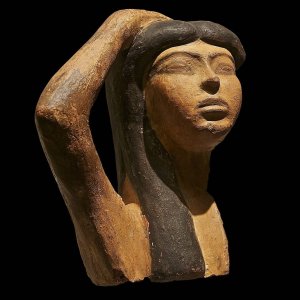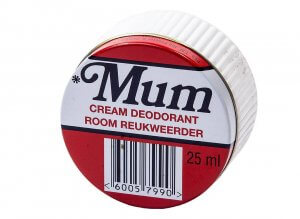Let’s face it. Sweat happens and always has since the dawn of man and stressful situations. It is a natural cooling mechanism that helps the body shed excess heat.
Armpits, particularly, have a higher density of sweat glands than other areas of the body. Sweat itself does not have a strong odor, but the bacteria on the skin breaking down the sweat within a damp armpit environment often do produce bad smells.
Bacteria thrive in the sweat emanating from the apocrine glands, which are located in the armpits, groin, and nipple areas, and sweat is high in protein, which bacteria can easily break down.
Reducing sweat is highly desirable because it often soaks through clothing.

Today, about 95% of Americans use some type of deodorant or antiperspirant, many of which are scented with fragrances created by our master perfumers at Alpha Aromatics.
But how do you build fragrances for products that are meant to control body odor? Which melange of fragrant notes will appeal more to today’s women and which to men? What if deodorant and/or antipersperant manufacturers want to go a more unisex route?
Our team explains!
A Brief History Of Body Odor And Body Deodorants
Down through time, however, when humans lived in caves, anthropologists believe that their body odor so bad that it actually repelled predators seeking sweeter smelling prey.
Ancient Egyptians invented the perfumed bath, which was followed by the application of a liberal amount of perfume to their underarms.

They were known to use carob, incense and even porridge as deodorant. The ancient Greeks also bathed and doused themselves in perfume. The Romans not only took baths in perfume, they also soaked their clothes in it, and scented their horses and household pets.
During the Middle Ages, people smelled even worse than their trash because the Church decreed that nakedness was a sin even when “practiced” in the bath. Dutiful parishioners barely maintained personal hygiene.
Those of the wealthier class tried to mask their stink with perfume, a practice that continued well into the 19th century.
The poorer populace remained as smelly as could possibly be. (It’s amazing to think about how they managed to reproduce, but then again, everyone probably smelled more or less the same.)
The Development of Modern Deodorants And Antiperspirants
It wasn’t until 1888 when the first patent for a waxy cream deodorant with a low content of zinc oxide appeared from an unknown Philadelphia inventor.
It was trademarked as “Mum” and sold as a cream, which users had to rub into their armpits.

This made it an unpopular application, as many users did not like the sticky, greasy residue it often left on clothing.
In addition, some complained that this early formulation had a peculiar smell.
The first antiperspirant, which thwarted both sweat-production and bacterial growth, was called Everdry and it launched in 1903.
This was an aluminum chloride solution that was applied with a cotton swab that took too much time to dry, was very messy and often ate through clothing. But users did not sweat, for whatever that was worth.
At the dawn of the 20th century, shadows of the Victorian era still prevailed and deodorants and antiperspirants were relatively new inventions.
Both these products didn’t fare well when first introduced because many people considered “sweat toiletries” to be unhealthy and unnecessary, with the conventional solution to body odor being to wash regularly and zap any emerging odor with perfume.
Those who were concerned about sweat seeping through clothing wore dress shields, cotton or rubber pads placed in armpit areas, which protected fabric from perspiration stains during the summer months of the year.
It would be Edna Murphy, an early female entrepreneur from Cincinnati, who at the Atlantic City Exposition in 1912 successfully promoted an antiperspirant paste named Odorono that her father, a surgeon, had invented to keep his hands sweat-free in the operating room.
Through clever marketing, a New York copywriter named James Young, singlehandedly altered the perception about deodorants and transformed them from unnecessary vagaries into marketable items by implanting the idea that they were necessary for proper social behavior and acceptance.
Odorono became Mum, and Mum Was The Word that marked the secret to a good social life.
In the 1960s, the first aerosol (Right Guard) launched a multi-billion dollar industry that has been expanding ever since.
Today, advances in industrial science allow leading perfume companies to create a myriad of options for the modern consumer that include an array of scents for both deodorants and anti-perspirants.
The Difference Between Deodorants And Antiperspirants
Deodorants and anti-perspirants both repel body odor, but they do so in different ways.
The key difference is the aluminum found in anti-perspirants, which temporarily block sweat pores and control the amount of sweat.

Deodorants eliminate armpit odor, but not perspiration.
Due to the fact that they are usually alcohol-based, when applied to the skin, it becomes more acidic, which in turn creates an unattractive environment for odor-causing pathogens.
Deodorants often contain perfume to mask odors and maintain under-arm freshness, whereas anti-perspirants do that and also help to control sweat, which is ideal if you want to avoid underarm wetness.
The Food and Drug Administration (FDA) considers deodorant cosmetic and anti-perspirant to be a drug.
Deodorants and anti-perspirants can be used either separately or in tandem. According to Kiran Mian, DO, a New York dermatologist: “If you use both, you should apply the anti-perspirant first on clean, dry skin, preferably at night before bed, which will give it time to activate overnight. For best results, apply deodorant in the morning.”
The labels on these products should clearly state that they contain both antiperspirant and deodorant properties.
Fragrances for these products should mostly focused on cleanliness and freshness.

A Few Relevant Trends And Statistics
According to a small 2005 study published in the Journal of the American Academy of Dermatology, both deodorants and antiperspirants can be effective at controlling body odor. In 2019, the global market was worth about 74.55 billion U.S. dollars.
According to Statista and based on the U.S.Census Data and Simmons National Consumer Survey (NHCS), some 298.7 million Americans used deodorants /anti-perspirants in the year, 2020. This figure is projected to increase to $306.04 million in 2024.
Growing at a CAGR of 4.0%, the market is expected to exhibit steady growth at least up until the year, 2026.
Experts believe this is due to a rising awareness of personal grooming.
Designing Fragrances For Products That Control Body Odor
We are a creator, manufacturer and purveyor of custom fragrances and a leader and pioneer within the perfume industry. Our master perfumers understand the power of fragrance and have been creating fine perfumes since the 1940s.

Our fine compositions are used for superior quality fragrances, personal care products, candles and diffusers, fragrances for home products and their odor neutralizers for those that use the services of private label manufacturers, custom packaging companies and toll blending (the specialty service of custom mixing a company’s unique formula into a final product).
Although the quality of the product itself is a much larger consideration than the infused fragrance, it is still an important factor in the overall appeal of the deodorant or anti-perspirant.
While some companies may opt for fragrance free or natural scents, others prefer traditional notes that have an appeal to both sexes.
The following list represents some of the more popular scents incorporated into deodorants and anti-perspirants.
Black Currant Tobacco
This primarily masculine scent opens with a flowing surge of aromatic, sweet and fresh bergamot, tangy and woody-nuanced raspberry and ammoniac, fruity black currant.
A heart note of intoxicating jasmine and spicy, hot clove fold into a final base note of herbaceous, woody and slightly mossy tobacco leaf, creamy sandalwood, earthy patchouli, sensual musk and elegant, lush vanilla.
Freshwater Amber
Pleasing, refreshing and citrusy bergamot, sour-sweet lemon and mildly, pungent and acidic sparkling water open this masculine fragrance.
These elements soon surrender to a a floral/herbal heart note bouquet featuring soothing green and aromatic lavender, rich, spicy and warm ginger and earthy, nutty sage.
The scent finishes with a final base note featuring piney and woody fir needle, balsamic somber cedar wood, sensual musk and dark honey-like amber.
Sandalwood Citrus
A citrus rush of succulent orange, sharp lemon and fresh, clean lime opens this masculine scent.
A herbal/ floral heart note bouquet soon follows marked by earthy rosemary, intense jasmine and green, musty and slightly sharp vetiver.
The fragrance completes with a base note comprised of buttery sandalwood, dry, earthy and green oak moss, sensual and passionate musk and dark rich amber.
Tea Leaf Peony
Opening with streams of dry, acidic and aromatic citron, floral, complex and mildly spicy bergamot, fruity, dense pear and sharp, citrusy pomelo, these feminine aspects quickly fade into a heart note marked by woody, sugary violet, potent, sweet and rosy peony and grassy, light and smooth green tea.
The scent finishes with a base note featuring creamy sandalwood, powdery, almond-like heliotrope and lush vanilla.
Water Lily Jasmine
This feminine fragrance opens with a fresh, peppery and slightly buttery rush of watercress and light, fresh and sea-like ozonic elements.
These aspects soon meld into a floral heat note marked by intense jasmine, fresh, shimmering water lily romantic, musky rose and sugary woody violet.
The scent finishes with a base note featuring sensual musk and sun-dried driftwood.
Wildflower Meadow
A burst of uplifting grapefruit and sharp, clean lime open this scent.
These elements soon acquiesce into a feminine, floral heart note marked by delicate, waxy and sweet lily-of-the-valley, creamy, lush wild flowers and bright, sugary and intoxicating sunflower blossom.
Earthy musk and woody elements complete this scent.
In Conclusion
Contact our team today and enhance your deodorant/anti-perspirant brand with our unforgettable line of fragrances that are certain to increase your company’s bottom line.
Final thought on deodorants: Common sense is like deodorant. The people who need it most never use it.~Bill Murray
Photo Credits: Pixabay
 alpha aromatics®
alpha aromatics®